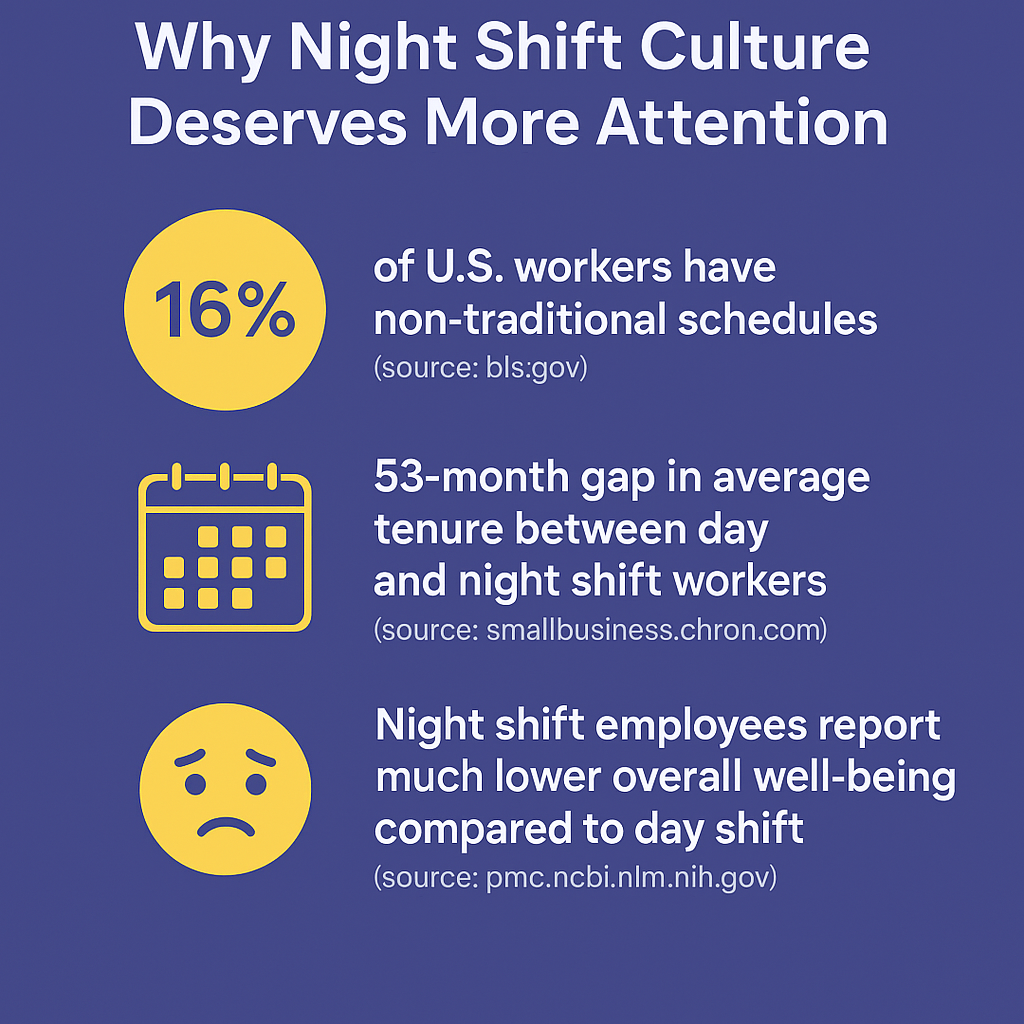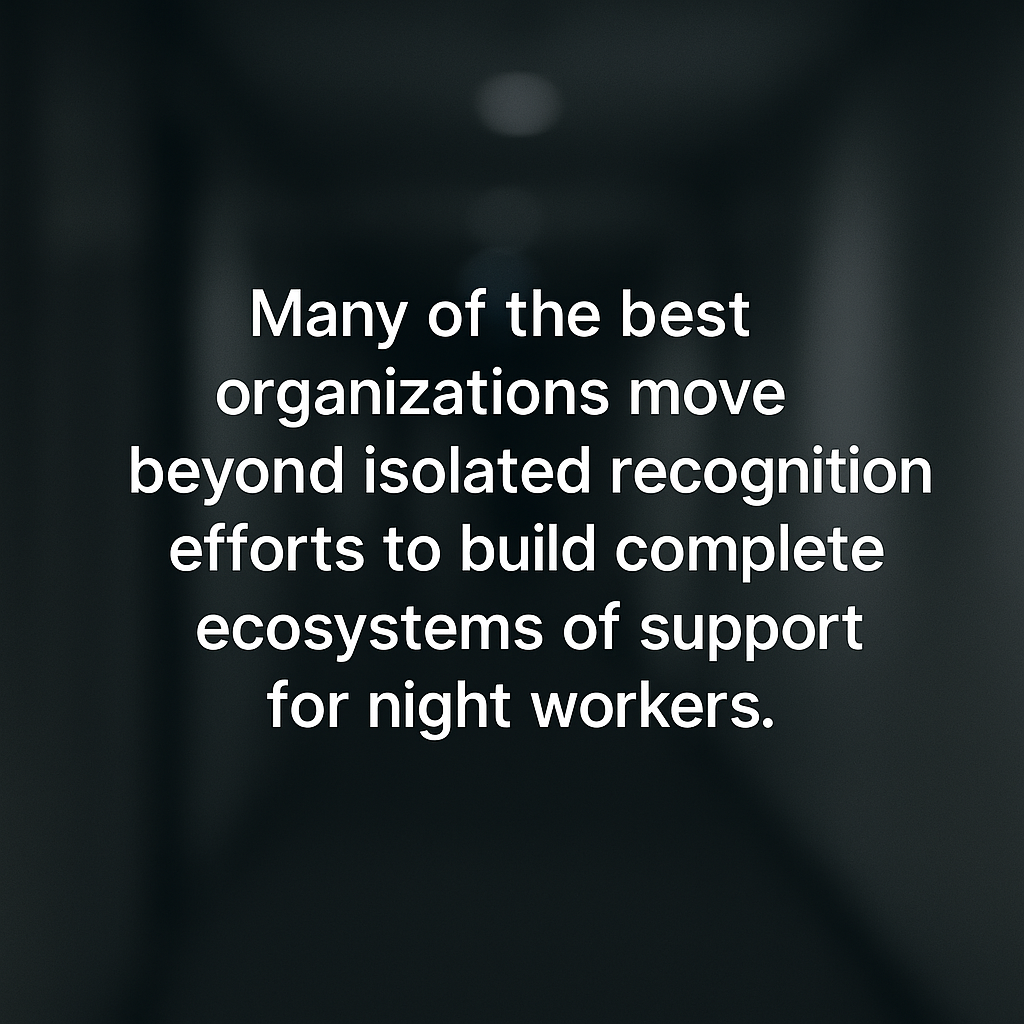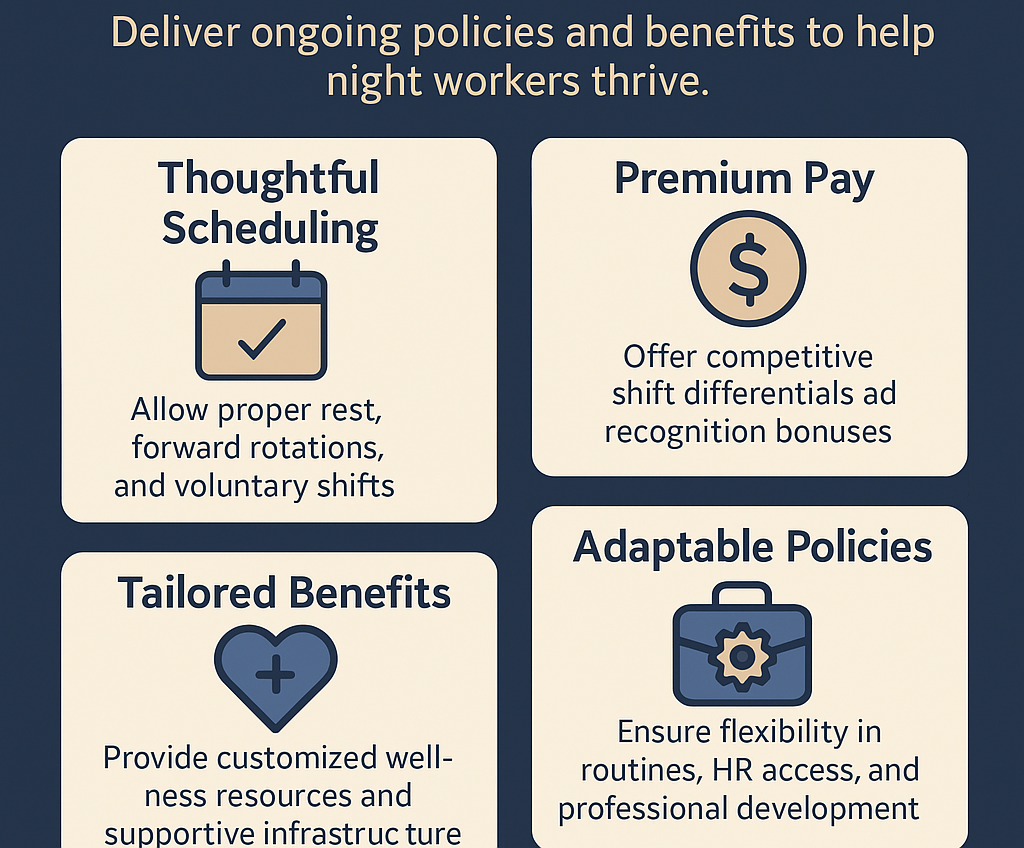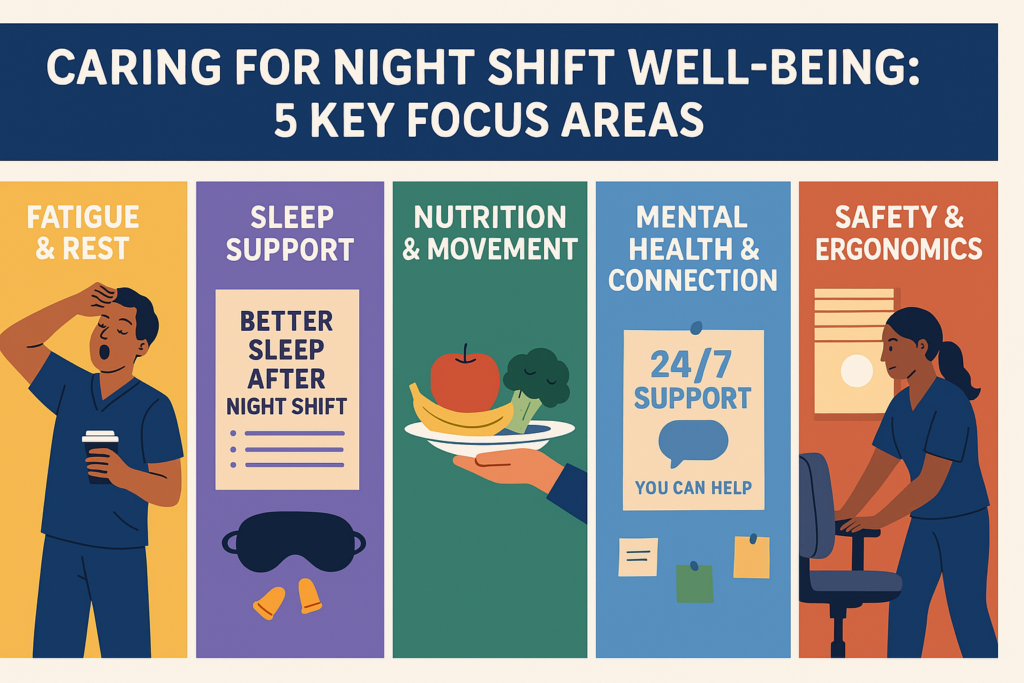Building a Better Workplace Culture for Night Shift Employees
This blog post explores how organizations can build a stronger, more inclusive, and supportive culture for their night shift employees. It highlights key workplace challenges night workers face and practical strategies that HR leaders, managers, and business decision-makers can implement to improve engagement, retention, and well-being.

Night shift employees keep businesses running 24/7, yet too often they feel like an afterthought in workplace culture. They make up a significant segment of the workforce with about 16% work outside the traditional 9-to-5 schedule.
However, studies show these “third shift” workers tend to have lower well-being and higher turnover than their daytime counterparts. In fact, one analysis found that day shift staff stayed with their company 53 months longer on average than night shift staff (smallbusiness.chron.com), underscoring the retention challenges when night teams feel undervalued.
Moreover, if not addressed, chronic night work can carry serious health risks and is even classified as a probable carcinogen (IARC).

For HR leaders and managers, the message is clear: building a positive, inclusive culture for night shift employees isn’t just a nice-to-have – it’s a business imperative. By making night workers feel valued, supported, and connected, organizations can boost engagement, reduce burnout and turnover, and improve overall performance. Below we explore five key areas where organizations can take action, with professional insights and practical tips to implement right away.
1. Inclusion and Recognition for Night Shift Workers
Night shift employees should feel like full members of the team – not “invisible” workers who come and go in the dark. Inclusion and recognition are critical for engagement. In fact, 84% of employees say recognition boosts their motivation, and those who feel appreciated are 45% less likely to quit (Gallup). Yet night teams often miss out on everyday perks of company culture that daytime staff enjoy. To close this gap, HR and leadership can institute practices that ensure night workers feel equally valued and seen. For example:
Duplicate Communications and Events:
- Don’t let night teams learn company news through the grapevine. If you announce policy changes or big wins on day shift, make sure to share the same announcements with second and third shifts (ideally in person or via live video).
- Consider holding important all-hands meetings twice – once during regular hours and once after midnight – or record them so night staff can participate. For social events like holiday parties or team-building activities, offer an equivalent celebration for night crews so they’re not left out.
Equal Access to Perks:
- Review company perks and amenities to ensure night employees get their fair share. If you provide free catered lunch for the day shift, offer a free dinner or midnight snack for the night shift. If the on-site gym or cafeteria closes at 6 p.m., arrange alternatives (24-hour vending with healthy options, stipends for meal delivery, etc.).
- These gestures send a powerful signal that night workers’ comfort and happiness matter just as much as everyone else’s.
Public Recognition:
- Incorporate night shift contributions into your recognition programs. When praising team successes, explicitly mention the behind-the-scenes efforts of night crew members.
- Highlight their achievements in company newsletters, internal social media, and town halls. Some companies create awards to honor outstanding overnight staff. Even a simple, sincere “thank you” from executives can go a long way.
- The goal is for night employees to feel seen and celebrated for the critical work they do.
Inclusive Culture Touchpoints:
- Little things can foster inclusion. Encourage day and night teams to leave brief overlap notes or handoffs (“Here’s what we finished, thank you for taking over!”).
- Create an internal chat channel or message board where all shifts share updates and shout-outs, so everyone feels part of one community. Small efforts to bridge the disconnect help night staff feel less like they’re on a lonely island.

By intentionally designing an inclusive culture – from communication to celebrations – companies signal that “out of sight” does not mean out of mind. When night shift employees feel truly integrated and appreciated, morale and loyalty naturally rise.
Many of the best organizations move beyond isolated recognition efforts to build complete ecosystems of support for night workers, recognizing that true inclusion requires a holistic approach that touches every aspect of the night shift experience.
2. Supportive Workplace Policies for Sustainable Night Shifts
Next, examine your workplace policies and benefits through the lens of night shift needs. Working overnight is inherently challenging, but smart HR policies can make it far more sustainable. Key areas to consider include scheduling, compensation, and flexibility:
Thoughtful Scheduling Practices:
- How you schedule night work can greatly impact employees’ health and work-life balance. Experts advise allowing at least 11 hours off between shifts to enable proper rest (cdc.gov).
- If rotating shifts, try to use forward rotations (day → evening → night) rather than backward; people adjust better when moving clockwise through shifts (cdc.gov). Also avoid permanently assigning someone to an unbearable schedule; instead, involve employees in designing rotation patterns that work for them.
- Some may prefer a steady overnight schedule for routine’s sake, while others appreciate rotating out periodically – flexibility is key. Whenever possible, allow night work to be voluntary or offer shift trading options, so those who thrive on nights can opt in and others aren’t stuck against their will.
Shift Differentials and Compensation:
- Because of the hardships of night work, many organizations provide shift differential pay or other financial incentives. This not only rewards night workers for their contribution but also helps attract and retain talent for these roles .
- A typical night shift premium can range from an extra 5%–20% or more on top of base pay. Evaluate your pay practices to ensure you’re offering a competitive differential – it sends the message that you recognize the sacrifice of working odd hours.
- Beyond pay, consider additional PTO or bonus programs specifically for night teams (for example, an extra day off earned after X consecutive night shifts, or a monthly bonus for meeting overnight productivity goals).
Flexible and Adaptive Policies:
- Rigid 9-to-5 oriented policies can inadvertently disadvantage night staff. Try to adapt benefits and routines to be “shift-neutral.” For instance, if your HR office or helpdesk operates only daytime, ensure night workers have an after-hours contact or self-service options for their HR needs.
- If training sessions or career development workshops are always scheduled at noon, provide equivalent sessions at midnight or offer recorded/e-learning alternatives, so night employees can participate in professional growth. As mentioned before, scheduling flexibility is also crucial – while some night roles require fixed hours on-site, others (like certain remote or IT monitoring roles) might be done on a more flexible timeline.
- Wherever feasible, allow employees to customize their work hours or split shifts to better fit their life. “The key to meeting employees where they are is avoiding a one-size-fits-all policy,” notes one CEO who offers flexible overnight scheduling (shrm.org).
- By listening to individual needs – whether it’s swapping shifts to attend a family event or adjusting start times – you demonstrate respect for your night team as people, not just “bodies filling a slot.”
Equitable Benefits and Resources:
- Do your night shift employees get the same level of support and benefits as day workers? Many organizations are complementing pay differentials with holistic benefits packages designed specifically for night shift lifestyles.
- These can include customized wellness resources, specialized learning opportunities, and support systems that address the unique challenges of the night shift. Audit things like health insurance, leaves, and wellness programs to ensure nothing inadvertently excludes night shift staff.
- Also, provide the tools and resources night staff need to do their jobs safely and effectively. This could mean having a dedicated night shift manager or supervisor on call for guidance (so night employees aren’t left without leadership support). Or providing transportation stipends for those who commute at odd hours when public transit is sparse.
- Some companies ensure there is always a senior leader rotating on night duty or available via phone, to empower night workers with decision-making support when needed. Such policies make overnight roles more sustainable and show that the company has built its infrastructure with night teams in mind, not as an afterthought.

In short, review your policies through the eyes of a night shift worker. Fair scheduling, extra compensation, and flexible benefit delivery can dramatically improve the day-to-day experience of overnight staff.
When night employees see that the organization has tailored policies to support them, they feel valued and are more likely to stay productive and committed for the long haul.
3. Leadership Engagement with Night Teams
Strong leadership and management practices are fundamental to a positive culture – and that includes on the night shift. One common pitfall is the “out of sight, out of mind” syndrome: managers (who usually work days) may inadvertently give night teams too little face time and feedback.
Third-shift workers often report being least comfortable sharing concerns with their manager, largely due to lack of interaction and an inherent disconnect in schedules. This gap can erode trust and engagement. It’s critical for leaders to actively bridge the divide and build relationships with night shift employees. Consider these strategies for better leadership engagement:
Be Present and Visible (Even at Odd Hours):
- Nothing replaces in-person connection. Managers of night teams should occasionally work or visit during the night shift to understand their routine and show support.
- For example, a nursing manager might come in for an overnight shift quarterly to listen to nurses’ concerns and observe workflow. An IT supervisor could rotate into a 1 a.m. systems deployment to assist the team. These visits don’t need to be frequent, but when they happen, they send a strong signal: leadership cares enough to meet night employees on their turf.
- If physically coming in is impossible, consider holding late-night video check-ins or “virtual office hours” so night staff can reach you. The key is to not let months go by without direct contact beyond email.
Establish Structured Check-Ins:
- In addition to ad-hoc visits, implement regular communication channels. Some organizations schedule mandatory team check-in meetings that include all shifts (using overlapping times or recorded video updates). Others have night shift representatives attend portions of daytime staff meetings (and vice versa) to facilitate two-way information flow.
- As a manager, set up one-on-one meetings with your night shift direct reports at intervals that make sense (perhaps monthly), even if it means adjusting your hours occasionally. Make it clear that your door (virtual or literal) is open for night staff.
- When third-shift workers have more opportunities to speak with managers, issues are more likely to be raised and resolved early, instead of festering silently.
Use Technology to Bridge Gaps:
- Leverage collaboration tools so that communication isn’t confined to overlapping hours. For instance, encourage night teams to use a platform like Slack or Teams to leave updates and questions for day managers (and ensure managers respond in a timely way when they log on).
- Shared project management tools with timestamped comments can keep everyone in the loop asynchronously. Even a simple end-of-shift email report from the night supervisor to the day supervisor can maintain continuity. By creating a culture of constant, open communication, night shift employees will feel less cut off from management support.
Empower a Night Shift Leader:
- If possible, designate a trusted senior staff member as the “night shift lead” or supervisor who acts as an extension of management. This person can make decisions on the spot, mentor newer night employees, and serve as a liaison who regularly briefs daytime leadership on night shift conditions.
- Having an on-site leader at night gives the team a sense of stability and representation. It also helps prevent the feeling that the night shift is operating on autopilot without any guidance until morning. Choose someone with strong leadership skills and ensure they have a direct line to higher management for escalation of any urgent matters.
Acknowledge and Appreciate Sacrifices:
- Leaders should explicitly recognize that working the graveyard shift comes with unique challenges. Small acts of gratitude go a long way – whether it’s a personal thank-you note to a night team or bringing in coffee for the 11 p.m. crew when you visit.
- “Demonstrate gratitude for employees who work the night tour and recognize the inconvenience and sacrifices they make in their personal lives,” advises one nurse manager (emergingrnleader.com). When night staff feel their managers truly understand and value their contributions, their sense of loyalty and morale soars.

Above all, avoid a two-tier culture where day shift is seen as the “main shift” and nights as a secondary crew. Managers must actively dispel this notion by giving night workers equal attention, development, and inclusion. Solicit their input on decisions (“How will this new policy affect your shift?”) and involve them in unit initiatives rather than excluding them.
By championing your night team and advocating for their needs, you build trust. Strong leadership engagement ensures that overnight employees feel supported – not stranded in a dark corner of the organization – which ultimately drives better performance and retention.
4. Prioritizing Night Shift Mental Health and Well-Being
Working through the night can take a toll on mind and body. Isolation, fatigue, and disrupted sleep cycles are part of the nightly battle, so organizations must go the extra mile to safeguard night shift employees’ health and well-being. This is both a moral responsibility and a smart investment – healthy, rested employees are more productive and less likely to make errors or quit. Here are ways organizations can support the mental and physical well-being of night workers:
Tackle Fatigue Proactively:
- Fatigue is one of the biggest risks for night shift staff, contributing to lower alertness and even safety incidents. Encourage night workers to take a 15-20 minute rest break to relax or to do some stretching and moving around to re-energize.
- Scheduling policies play a role here too – as mentioned, flexible rotations and ensuring adequate rest days helps prevent cumulative exhaustion. Also consider providing free caffeine (coffee, tea) and healthy snacks to night staff to help them stay alert during the wee hours.
- Just be mindful to also educate about moderation and the timing of caffeine use (e.g. avoid heavy caffeine toward the end of the shift, so it doesn’t ruin daytime sleep).
- Some employers will even allow brief power naps during night shifts (in a designated quiet room and within prescribed time limits). On-shift naps may not be feasible in many organizations, but research does show that a short nap before or during a night shift can significantly boost alertness and cognitive performance (pmc.ncbi.nlm.nih.gov).
Create a Healthy Sleep Culture:
- Employers can assist night workers in managing the tricky task of sleeping during the day. Offer guidance and resources on good sleep hygiene. For example: share tips about keeping the bedroom dark and cool, using earplugs or white noise machines to block daytime noise, and wearing sunglasses on the commute home to minimize morning light exposure that can disrupt sleep.
- Some companies have brought in sleep experts or circadian specialists to coach their night teams. Additionally, ensure your health plans or wellness programs address sleep disorders. Night shift workers are at higher risk for issues like insomnia or shift work disorder, so facilitating quick access to sleep clinics or medical evaluation is valuable.
Nutrition and Exercise Support:
- Odd hours can wreak havoc on eating and exercise routines. Organizations can help by making healthy food readily available on the night shift – stocking vending machines and break rooms with nutritious options, or occasionally catering healthy meals for overnight crews. This helps counteract the tendency to grab junk food out of convenience at 3 a.m. Some employers even organize group meal prep or cooking demos for night staff to encourage healthy eating habits off the job.
- Physical activity is another challenge; when you sleep during the day and work at night, finding time to exercise is tough. Consider offering on-site fitness facilities to night workers or memberships to 24-hour gyms, and promote short exercise breaks. Something as simple as a brisk 10-minute group walk around the facility during a quiet period can improve mood and alertness. By integrating wellness into the night shift (maybe a gentle stretching session at 2 a.m. led by a volunteer), you help employees manage stress and stay healthier.

Mental Health Resources and Social Connection:
- Working when most others sleep can be lonely. Night employees might miss out on family events and feel isolated from coworkers on other shifts. It’s important to provide mental health support geared toward these challenges. Ensure that Employee Assistance Programs (EAPs) or counseling services are accessible during overnight hours.
- Normalize conversations about the strain of night work and encourage peer support – for example, start a support group or team group chat where night shift colleagues can share tips or just vent to those who understand. Consider organizing occasional meetups that bring together night shift staff with their families for a social gathering (perhaps a weekend barbecue in the evening or breakfast event after a shift) to foster a sense of community and belonging.
- Reducing the sense of isolation will improve overall mental well-being. Also train managers to watch for signs of burnout or depression in night workers, since they might be less likely to voice concerns. A compassionate check-in – “How are you holding up? Anything we can do to support you?” – can open the door to someone asking for the help they need.
Safety and Ergonomics:
- Finally, prioritize the physical safety of night shift workers, which ties into peace of mind. Ensure parking lots and work areas are well lit at night and if applicable, that security is available to escort staff.
- Evaluate ergonomics for overnight roles. For instance, if a job requires repetitive tasks at 4 a.m. when concentration is low, make sure to rotate duties or provide tools to reduce strain. Reducing workplace hazards and injuries on the night shift will alleviate stress and show employees that their well-being is taken seriously at all hours.
By investing in wellness initiatives targeted at the unique needs of night shift employees, organizations can mitigate the well-documented health risks of night work. Healthier night workers mean better focus, fewer errors, and lower absenteeism.
More importantly, demonstrating genuine care for their holistic well-being – physical, mental, and social – builds trust and loyalty. It tells your night teams that “we’ve got your back,” fueling a positive culture even in the toughest hours of the night.
5. Real-World Examples and Best Practices
Many organizations have recognized the importance of night shift culture and implemented creative solutions. Here are just a few real-world examples and high-impact practices that other organizations can learn from:
Co-op’s “Night Club” Sleep Workshop:
- The British retail chain Co-op, with nearly half of its 56,000 frontline employees working nights, launched an innovative program to support their well-being. In partnership with sleep scientists and funded by the Wellcome Trust, they created a workshop called Night Club for night shift staff. This wasn’t a party, but an educational seminar where employees could meet outside of work, learn about healthy sleep habits, and even consult one-on-one with sleep researchers about their questions.
- The aim was to foster a healthier 24-hour work culture by bringing cutting-edge research directly to employees. Co-op’s initiative shows the power of investing in expert resources to help night workers adapt – it’s an approach that not only educated staff but also made them feel deeply valued by their employer. Read more on this at hrmagazine.co.uk.
Indiana University Health’s Night Shift Appreciation:
- At IU Health (a large nonprofit healthcare system), leadership recognized the hardships of overnight hospital staff and took concrete steps to show appreciation. Night shift employees (7 p.m. to 7:30 a.m.) are paid more than daytime workers, providing a financial acknowledgment of the difficulty of those hours (shrm.org).
- Additionally, the hospital sometimes surprises the night team with free meals during busy periods or holidays, and has been known to set up special coffee bars or even ice cream stations as a “thank you” treat.. “We hope these gestures help communicate how appreciated our night-shift team members are,” says Mandy Bates, VP of HR at IU Health (shrm.org).
- This example illustrates that a combination of policy (pay differential) and spontaneous gestures of gratitude can boost night shift morale. Even small perks, delivered authentically, remind night employees that the organization sees their hard work.
Manufacturing & Industrial Best Practices:
- In many manufacturing plants and warehouses, night shifts are critical. Leading companies in these sectors focus on safety and teamwork to keep culture strong overnight. For example, one major automotive manufacturer limits night shift length to 8 hours (instead of 12) to reduce fatigue-related accidents, following research that night shift error rates are significantly higher beyond 8-9 hours.
- Others implement a “buddy system” on night shift – pairing up coworkers to check on each other’s alertness and rotate tasks – to combat monotony and safety risks. It’s also common to have brief shift crossover meetings where the outgoing day shift and incoming night shift share updates and even spend a few minutes in informal conversation, reinforcing camaraderie across shifts.
- These practices show how focusing on safety, reasonable hours, and team cohesion can make night shifts safer and more satisfying.
Tech and Remote Work Adaptations:
- Some tech companies and global firms operate around the clock with “follow the sun” support teams. A best practice here is to equip night shift remote employees with the same collaboration tools and rituals as daytime teams, so they never feel second-class.
- For instance, a customer support company might have a daily stand-up video call that includes both the tail end of the EMEA shift and the start of the APAC night shift together, creating a sense of one continuous team. Managers also ensure that recognition is time-zone agnostic – e.g., an employee in the midnight shift in Manila receives the same public kudos in the company Slack channel as someone in the New York morning shift.
- By making distributed night workers full participants in the team culture (rather than leaving them in a silo), these companies maintain high engagement.
Emphasizing Work-Life Balance:
- Lastly, organizations known for great night shift cultures help their employees maintain work-life balance despite the unconventional schedule. Some hospitals offer counseling for family members of night nurses to help them adjust to the loved one’s schedule and find quality time together.
- Other organizations ensure that night workers have equal opportunity to take weekends off on rotation, so they don’t feel they “live at work.” These efforts acknowledge that a healthy home life and personal well-being are integral to work performance, and they strive to prevent night shift work from overwhelming an employee’s life.

In summary, the common thread in these examples is empathy and intentionality. Organizations that excel with their night shift teams don’t treat overnight workers as interchangeable cogs or assume “no news is good news.”
Instead, they actively listen to these employees, invest in their well-being, include them in the culture, and recognize their contributions in meaningful ways. Any organization can start adopting these best practices, even on a small scale, to improve the night shift experience.
Conclusion: Brightening the Night for Your Employees
Night shift employees are doing critical work. They deserve a workplace culture where they feel just as connected, supported, and appreciated as the day shift. By focusing on inclusion and recognition, implementing supportive scheduling and pay policies, engaging leadership with night teams, and championing health and well-being initiatives, companies can transform the overnight work environment.
The payoff for these efforts is significant – higher engagement, lower turnover, fewer safety incidents, and employees who are motivated to give their best.
HR professionals and leaders should evaluate their current practices and ask: “Would I feel valued and cared for if I worked the night shift here?” If the answer is anything less than yes, use the strategies and examples we have provided as a roadmap for improvement. Start with a few actionable changes – maybe hold a listening session with your night crew, or pilot some new changes that were designed with their input. Small steps can make an immediate difference.
A Few Actionable Takeaways for Leaders:
- Schedule regular check-ins and presence on the night shift (in-person or virtual) to stay connected with overnight employees.
- Mirror important communications and events for night staff – never let them be the last to know news or miss out on celebrations.
- Offer shift differentials, adequate rest breaks, and flexible scheduling to support the unique demands of night work.
- Invest in wellness resources (sleep education, healthy food, fitness access) and make mental health support easily available during off-hours.
- Publicly recognize and reward the contributions of night teams, fostering an inclusive one-company culture across all shifts.
A better culture for night workers isn’t just a nice idea – it’s an achievable goal that delivers real results for your people and your organization. As awareness has grown about the unique needs of night shift workers, we’re seeing the emergence of specialized solutions that bring together best practices from across industries.
These comprehensive approaches recognize that night shift success requires addressing physical health, mental wellbeing, community connection, and professional development as an interconnected ecosystem rather than as isolated challenges. Great organizations prove themselves by how they support night shift employees, not just with words, but with commitment, presence, and follow-through.
The standard you set after dark says everything. Over time, building a strong culture for night shift employees will not only benefit those workers, but will strengthen your organization overall. Celebrating them and setting them up for success creates a win-win culture where employees and the organization can thrive together, around the clock.

![Photo of [object Object] in undefined](https://nightowling.com/wp-content/uploads/2025/11/image-17.png)
